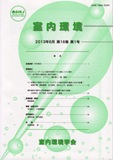This research was performed in order to analyze microbial volatile organic compounds (MVOCs) as indicators of growing or hidden mold damage in indoor area of residence. More than 200 compounds have been reported as MVOCs. Among these MVOCs, 15 most often reported compounds are considered to be probable indicators for mold growing.
MVOCs, wide range volatile compounds classified into from VVOC to SVOC, require various modifications of operating conditions of the apparatus. There are no standard method for sampling and analyzing MVOCs. Canister sampling can accomodate both long and short term sampling of MVOCs and it does not make much noise during operation. From this point, canister sampling is more practical than the traditional solid phase adsorption methods followed by thermal desorption or solvent extraction of VOCs. After canister sampling, automated microscale purge & trap coupled with gas chromatography / mass spectrometry (GC/MS) analysis has been employed for the analysis of typical 15 compounds, including 2-MIB and geosmin. While a conventional system coupled glass beads trap with Tenax trap adopted in EPA TO-14 method for outdoor VOCs was restrictively successful, sufficient result was obtained using double traps piled glass beads with Tenax. The quantitation limit ranged between 0.0088 and 0.16 ng in both cryotrap systems.
The purpose and goal of this study was to examine the relation between the exposure to MVOCs owing to indoor mold growth and the prevalence of adverse health effects on the residents. The procedure has been tentatively applied in the context of a field study to measure the indoor MVOCs in several houses. 1-octen-3-ol detected in all houses ranged from 1.34-10.2 μg/m
3, with an average in 6 houses of 4.09 μg/m
3, and a slight amount of five MVOCs was also detected. The total MVOCs was detected at 2.43-16.4 μg/m
3 with an average of 6.95 μg/m
3.
View full abstract
